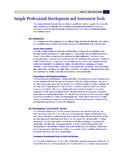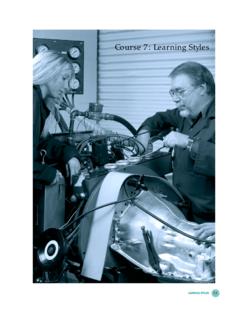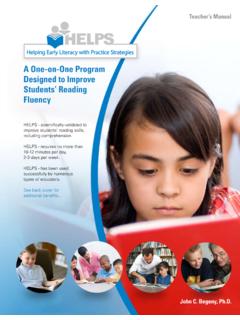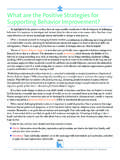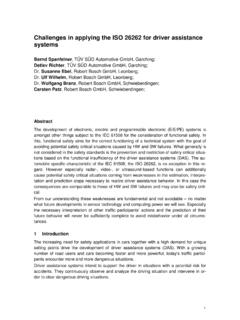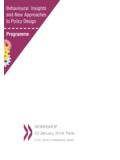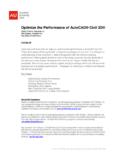Transcription of Course 3: Planning for Instruction - Careers in Ed
1 Planning for InstructionCURRICULUM GUIDE: Planning FOR 3: Planning for InstructionCURRICULUM GUIDE: Planning FOR Standard: B. Develop Outcomes, Assessments and CurriculaKey Activities:B2. Create, evaluate, and modify Standard: D. Provide Student InstructionKey Activities:D1. Prepare and/or gather current instructional materials Modify instructional material and methods based on studentand industry assessments and for Instruction Editor s Note: The two levels indicated in this Course relate to the level of knowledge andexperience of the instructor-learner.
2 Level I relates to the brand new instructor and contains critical outcomes. Level II relates to the slightly more experienced instructor and focuses onapplication and assessment of DESCRIPTION:Instructor-learners plan for the delivery of adult Instruction by creating instructionalmaterials appropriate for students of diverse backgrounds and learning styles. Instructor-learners develop the skills required to create, evaluate or modify a Course through theconstruction of lesson plans and Course syllabi. This Course assists instructor-learners inways to plan lessons and units of Instruction and to identify textbooks, instructionalmedia and resources.
3 Emphasis is on lesson Planning and syllabus development,particularly as they relate to higher order thinking skills such as Bloom s Taxonomy anddomains of OUTCOMES: The instructor-learner will:LEVEL I Create, gather and organize quality instructional materials and media in support ofcurriculum outcomes and diverse learning styles. Align assessments with program outcomes and diverse learning styles. Modify assessments based on student and industry feedback. Develop well-organized student-centered instructional activities and lesson OUTCOMES The instructor-learner will:LEVEL II Evaluate and customize quality instructional materials, resources, and media in supportof curriculum outcomes and diverse learning styles that also meet the requirements ofapproved policies and procedures.
4 Modify instructional plans and activities after assessing effectiveness of developedmaterials and media. Apply Bloom s Taxonomy to instructional methods and assessments. As needed, access a variety of campus resources and personnel in preparation for InstructionCURRICULUM GUIDE: Planning FOR OUTCOMES ASSESSMENT, LEVEL I: Construct and complete a syllabus that indicates all segments of Course Planning ,including Course description, learning outcomes, competencies, Course content,objectives, assessment tools, content assessment, and ADA accommodations.
5 Select and apply a variety of instructional methods for specific student learning outcomesand Course , LEVEL II: Apply deliberate criteria, including college, local, state, industry, and federal policies andguidelines and knowledge of learning styles and instructional strategies in the selectionand design and/or customization of instructional materials, resources, and media. Obtain appropriate approval and support for the use of a selected set of instructionalmaterials and or systems. Actively explore opportunities for team teaching and Planning with other disciplineswithin their INDICATORS: Instructional materials and equipment are identified to support program outcomes andappeal to multiple learning styles and diverse learners.
6 Instructional materials and equipment selected are approved in accordance with collegepolicies and procedures. Campus resources are consulted to ensure availability of instructional materials andequipment. Lesson plans are organized to provide regular opportunities for students to activelypractice, perform, and receive feedback on all required skills. Learning activities and lessons are directed toward program and student outcomes andcompetencies and industry standards. Course sequence supports student success at achieving outcomes and competencies. Course and curriculum properly align with accrediting bodies, college mission, andprogram goals and are driven by workforce needs.
7 Syllabi includes Course descriptions, student learning outcomes, Course competencies, Course content, objectives, assessment tools, content assessment, ADAaccommodations, Course prerequisites, and grading requirements. Course is regularly reviewed by advisory committee and/or accrediting bodies as requiredand meets all legal requirements. When appropriate, flexibility is built into the Course to address individual student AND SKILLS: The instructor-learner will: Demonstrate knowledge of program outcomes. Identify sources of instructional materials and demonstrate the ability to access suchsources. Demonstrate knowledge of adult learning styles and diverse teaching methodologies.
8 Apply knowledge of state/federal and college requirements and guidelines regardinginstructional materials and media. Select and revise appropriate types of instructional materials and teaching strategies,including lecture, demonstration, lesson, discussion, tutorial, workshop practice, projects,case study, or role play as appropriate, that support curriculum outcomes. Develop implement and demonstrate effective lesson GUIDE: Planning FOR LEARNING ACTIVITIES: Identify and collect resources for textbook selection as determined by college and incollaboration with program advisory committee. Apply Bloom s Taxonomy to Course design, objective development, and studentevaluation.
9 Write Course competencies and student learning outcomes and performance objectives. Construct a variety of methods for student evaluation. Determine Course boundaries for Course content. Identify Course prerequisite skills and develop methods for assessing whether prerequisiteskill requirements are met by entering students. Subdivide Course content into appropriate units of Instruction . Utilize members of advisory committee to review and evaluate lesson and Course designand content. Identify links between lessons, Course , curriculum, and state and accreditationrequirements. Interpret and apply new knowledge and formulate lesson and Course design.
10 Support team teaching/cross disciplinary education. SELECTING INSTRUCTIONAL MATERIAL AND MEDIAE ssential Content Discussion Topics and Key PointsTypes of instructional Textbooks, reference materials, audiovisuals, websites, handouts,material and mediasimulations, flipcharts, props Media- Smart Boards, overheads/viewfoils, software, lab equipmentCriteria for selecting and developing College, state and federal requirementsinstructional material and media Copyright and intellectual law (See Course #14: Educational Law) Providing for diverse learners and various learning styles (SeeCourse #7.)


